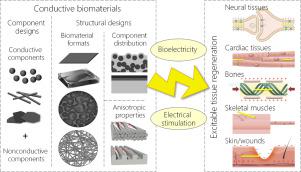Progress in Polymer Science ( IF 27.1 ) Pub Date : 2022-06-03 , DOI: 10.1016/j.progpolymsci.2022.101573 Guoxu Zhao , Hongwei Zhou , Guorui Jin , Birui Jin , Songmei Geng , Zhengtang Luo , Zigang Ge , Feng Xu

|
Cells in vivo are situated in a complicated microenvironment composed of diverse biochemical and biophysical cues. To regulate biological functions of cells, tissues and organs bioelectricity (i.e., electrical cues) plays a particularly important role. Along with the development of tissue engineering and regenerative medicine (TERM), the positive effects of bioelectricity on the regeneration of excitable tissues have been well recognized through promoting cell proliferation, differentiation and migration and tissue functionalities. Conductive biomaterials have emerged as enabling tools to improve the outcomes of excitable tissue regeneration by facilitating the transmission of endogenous bioelectricity or electrical stimulation to electrically-isolated cells and tissues. Moreover, advanced electrical functionalities of conductive biomaterials can realize more controllable and smart TERM approaches. In this review, conductive biomaterials employed for TERM applications are comprehensively reviewed. First, the biological basis underlying the function of conductive biomaterials is introduced. Second, rational design strategies for conductive biomaterials displaying favorable microenvironmental cues (e.g., electrical, mechanical, structural) and electrical functionalities are summarized from the aspects of conductive and nonconductive components, biomaterial formats, spatial distribution of components, and anisotropy. Subsequently, strategies for the application of conductive biomaterials in TERM of excitable tissues, including nerves, myocardium, skeleton muscles, bones and skin/wounds, are reviewed. Finally, the future perspectives of conductive biomaterials for TERM applications are given.
中文翻译:

可兴奋组织再生的导电生物材料的合理设计
体内细胞位于由多种生化和生物物理线索组成的复杂微环境中。调节细胞、组织和器官生物电的生物学功能(即,电提示)起着特别重要的作用。随着组织工程和再生医学(TERM)的发展,生物电通过促进细胞增殖、分化和迁移以及组织功能等对可兴奋组织再生的积极作用得到了广泛认可。通过促进内源性生物电或电刺激向电隔离的细胞和组织的传输,导电生物材料已成为改善可兴奋组织再生结果的工具。此外,导电生物材料的先进电气功能可以实现更可控、更智能的 TERM 方法。在这篇综述中,对用于 TERM 应用的导电生物材料进行了全面综述。第一的,介绍了导电生物材料功能的生物学基础。其次,显示有利微环境线索的导电生物材料的合理设计策略(例如,电气、机械、结构)和电气功能从导电和非导电组件、生物材料格式、组件的空间分布和各向异性等方面进行了总结。随后,综述了导电生物材料在神经、心肌、骨骼肌、骨骼和皮肤/伤口等可兴奋组织TERM中的应用策略。最后,给出了用于 TERM 应用的导电生物材料的未来前景。


























 京公网安备 11010802027423号
京公网安备 11010802027423号